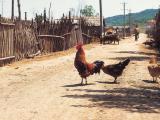Toward the end of 2023 as Cambodia faced a dramatic rise in human H5N1 avian flu cases, the country's scientists identified a novel reassortant that combined genes from an older 2.3.2.1c clade known to circulate in Southeast Asia with internal genes from the newer 2.3.4.4b clade that has spread globally, infecting a wide range of animals, even reaching Antarctica.
In a preprint study yesterday, a team led by the Pasteur Institute in Cambodia published a detailed genetic analysis of the novel H5N1 reassortant, which yielded new details on the spillover timeline and emphasized the need for stepped-up surveillance.
Virus has worrisome mutation
After almost a decade with no human H5N1 cases, Cambodia experienced a startling rise in infections, with 16 cases reported from February 2023 to August 2024. Investigators found that patients had contact with sick poultry or poultry environments. At least three of the patients died from their infections. No human-to-human spread was reported.
The team's genomic analysis revealed two spillover phases, one in February 2023 caused by the older 2.3.2.1c clade and one that began in October 2023 that involved the novel reassortant that combined genes from the two clades.
Examination of the viruses from Cambodian poultry found that the novel reassortant has replaced the circulating 2.3.2.1c clade.
The new virus has mutations, including PB2 E627K, that have been linked to adaptation to mammals and airborne transmission.
Critical need for more risk assessment, surveillance
The authors praised Cambodia's One Health response to the spike in human cases and said more efforts are needed to reduce human exposure to the virus, especially in higher-risk rural areas. Also, they said more training is needed for healthcare workers on early detection and clinical case management.
More risk assessment studies are critical to help better understand the zoonotic risk from the new reassortant, the group wrote. "In addition, the detection of the PB2 627K mutation in poultry is 296 also a concern, as it may become established in widespread circulation."
The surge in human cases underscores the ongoing threat from avian influenza viruses to global health security, and despite the global attention on the expanded host range of the 2.3.4.4b clade, 2.3.2.1c remains a concern in Asia, where both clades cocirculate.



















